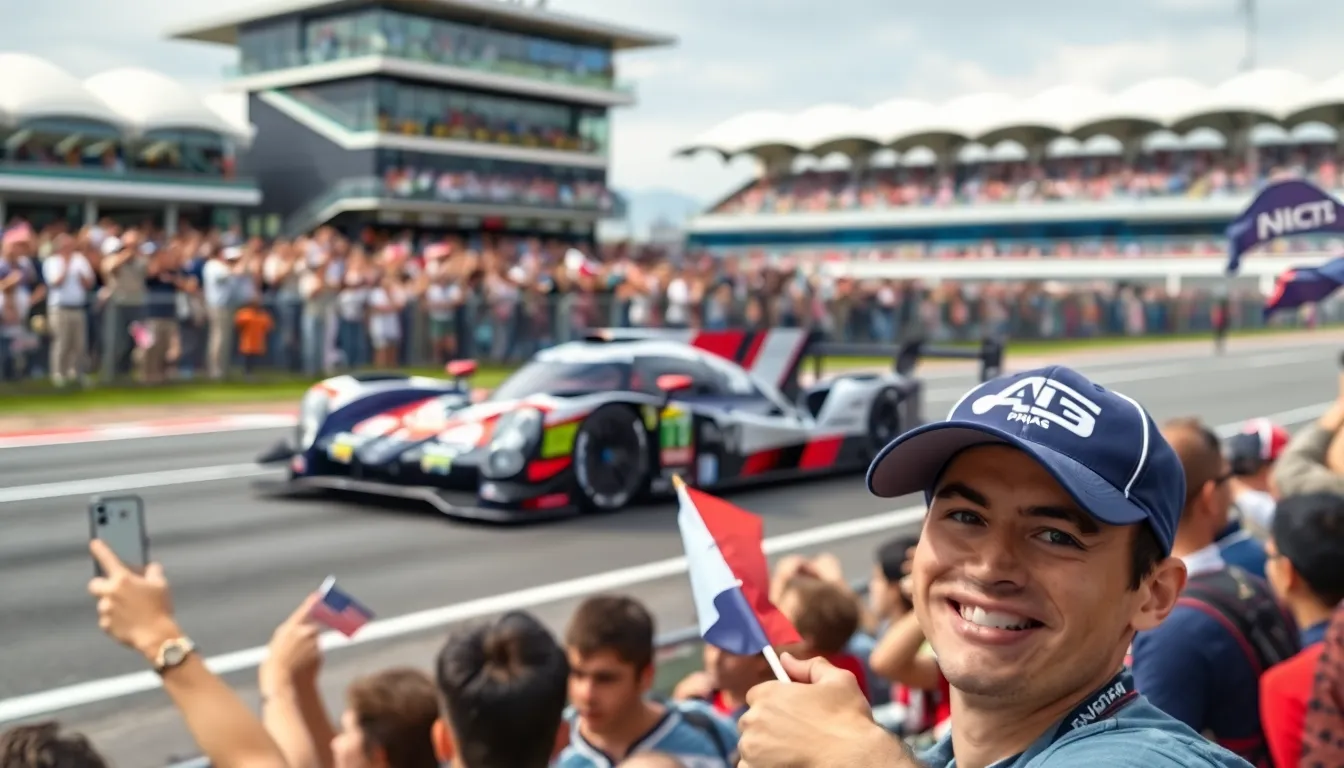We’ve all witnessed the thunder of engines roaring down the Mulsanne Straight, but Le Mans cars represent something far beyond mere speed. These purpose-built racing machines embody the ultimate test of endurance, engineering excellence, and human determination across 24 grueling hours of competition.
At the legendary Circuit de la Sarthe, we see automotive manufacturers push the boundaries of what’s possible. From the iconic Ford GT40 that dominated the 1960s to today’s cutting-edge LMP1 hybrids, Le Mans cars showcase revolutionary technologies that eventually trickle down to our everyday vehicles. These aren’t just race cars – they’re rolling laboratories where aerodynamics, fuel efficiency, and reliability converge.
Whether you’re fascinated by the Porsche 919 Hybrid’s record-breaking performance or curious about the latest LMH regulations, understanding Le Mans cars opens a window into motorsport’s most demanding arena. We’ll explore what makes these machines so special and why they continue to captivate racing enthusiasts worldwide.
The Evolution of Le Mans Cars Through the Decades
Le Mans racing has transformed dramatically since its inception, with each era bringing revolutionary changes that shaped automotive history. We’ve witnessed incredible technological leaps and design innovations that continue to influence modern motorsport.
Early Racing Pioneers of the 1920s and 1930s
Bentley Speed models dominated the inaugural decades of Le Mans racing. These British machines won five consecutive races from 1924 to 1930, establishing endurance racing as a legitimate motorsport discipline. We see how manufacturers like Bentley, Alfa Romeo, and Bugatti built their reputations on grueling 24-hour battles.
Traditional craftsmanship defined these early racing machines. Mechanics hand-built each component using techniques borrowed from luxury car production. We observe that drivers needed exceptional physical stamina to handle heavy steering wheels and primitive suspension systems for entire day-night cycles.
Simple aerodynamics governed vehicle design during this period. Racing cars featured long bonnets, exposed wheels, and minimal bodywork that prioritized mechanical reliability over wind resistance. We notice that average speeds rarely exceeded 80 mph due to basic braking systems and narrow tire technology.
Post-War Innovation in the 1950s and 1960s
Ferrari emerged powerfully as Le Mans’ most successful manufacturer during the golden age of sports car racing. Italian engineering excellence produced legendary models like the 250 GTO and 330 P series that combined beauty with performance. We recognize this era for introducing disc brakes, fuel injection systems, and lightweight aluminum construction.
Ford’s GT40 program revolutionized American involvement in European endurance racing. Henry Ford II’s personal mission to defeat Ferrari resulted in four consecutive victories from 1966 to 1969. We appreciate how this rivalry pushed both manufacturers to develop advanced aerodynamic packages and powerful V8 engines.
Porsche 917 vehicles redefined speed capabilities at Circuit de la Sarthe. These German machines reached unprecedented velocities exceeding 240 mph on the famous Mulsanne Straight. We understand that their distinctive flat-twelve engines and innovative fiberglass bodywork established new benchmarks for racing car development.
Modern Era Technological Advancements
Hybrid powertrains transformed Le Mans competition starting in the 2010s. Toyota, Audi, and Porsche developed sophisticated energy recovery systems that captured braking energy and deployed electric assistance. We’ve seen these LMP1 hybrid prototypes achieve remarkable fuel efficiency while maintaining competitive lap times.
Carbon fiber construction became the standard material for modern Le Mans cars. This lightweight composite allows engineers to create incredibly strong chassis that protect drivers during high-speed crashes. We observe that contemporary racing machines weigh significantly less than their predecessors while offering superior safety protection.
Advanced electronics control virtually every aspect of modern endurance racing vehicles. Sophisticated data acquisition systems monitor hundreds of parameters in real time, helping teams optimize performance throughout the 24-hour race. We note that telemetry technology now enables engineers to make precise adjustments remotely during competition.
Iconic Le Mans Cars That Changed Racing History
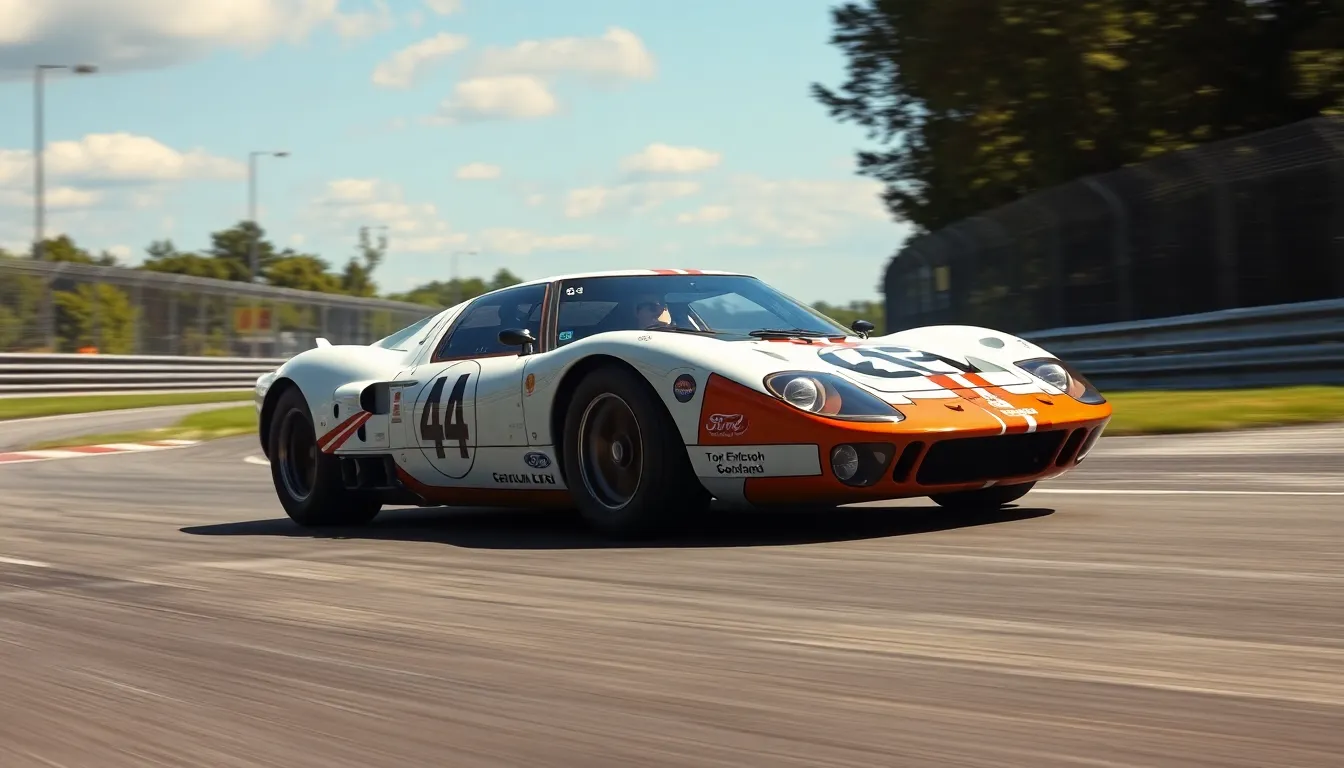
Throughout motorsport history, certain Le Mans cars have transcended mere competition to become legendary symbols of innovation and triumph.
Ford GT40: American Dominance in the 1960s
Ford’s GT40 represents one of motorsport’s most remarkable vengeance stories, transforming American racing ambitions into European conquest. We witness how Henry Ford II’s determination to defeat Ferrari at Le Mans created an engineering masterpiece that dominated the Circuit de la Sarthe from 1966 to 1969.
Engineering brilliance defined every aspect of the GT40’s design, from its lightweight monocoque chassis to the thunderous 7.0-liter V8 engine producing over 485 horsepower. Aerodynamic innovations included the car’s distinctive low-slung profile, measuring just 40 inches tall, which gave the vehicle its iconic name.
Victory came decisively in 1966 when Ford GT40s claimed the top three podium positions, marking America’s first Le Mans triumph. Subsequent wins in 1967, 1968, and 1969 established Ford’s legacy as the manufacturer that brought American muscle to European endurance racing excellence.
Porsche 917: Engineering Excellence Personified
Porsche’s 917 redefined what Le Mans cars could achieve, pushing the boundaries of speed and aerodynamic sophistication beyond previous limits. We recognize this machine as the vehicle that elevated Porsche from sports car manufacturer to Le Mans legend during the early 1970s.
Performance capabilities of the 917 shocked the racing industry with its 4.5-liter flat-12 engine generating up to 630 horsepower in race trim. Advanced features included magnesium space frame construction, revolutionary aerodynamic packages, and innovative weight distribution that allowed drivers to reach previously unimaginable speeds.
Dominance characterized Porsche’s 917 era at Le Mans, securing consecutive victories in 1970 and 1971 while setting multiple speed records. Racing versions achieved top speeds exceeding 240 mph on the Mulsanne Straight, establishing benchmarks that influenced Le Mans car development for decades.
Audi R8 and R10: Diesel Revolution at Le Mans
Audi’s R8 and R10 programs revolutionized Le Mans racing by proving that diesel technology could outperform traditional gasoline engines in endurance competition. We observe how these groundbreaking vehicles changed perceptions about diesel powertrains in high-performance motorsport applications.
Technological innovations in the R10 TDI included a twin-turbocharged 5.5-liter V12 diesel engine producing exceptional torque while consuming significantly less fuel than gasoline competitors. Advanced systems featured cutting-edge aerodynamics, lightweight carbon fiber construction, and sophisticated electronic management that optimized performance throughout 24-hour races.
Championship success followed immediately, with the R10 TDI claiming victory at Le Mans in 2006, 2007, and 2008, demonstrating diesel supremacy in endurance racing. Efficiency advantages allowed Audi teams to complete fewer pit stops than rivals, while superior torque delivery provided consistent lap times throughout grueling race conditions.
Different Categories of Le Mans Cars Competing Today
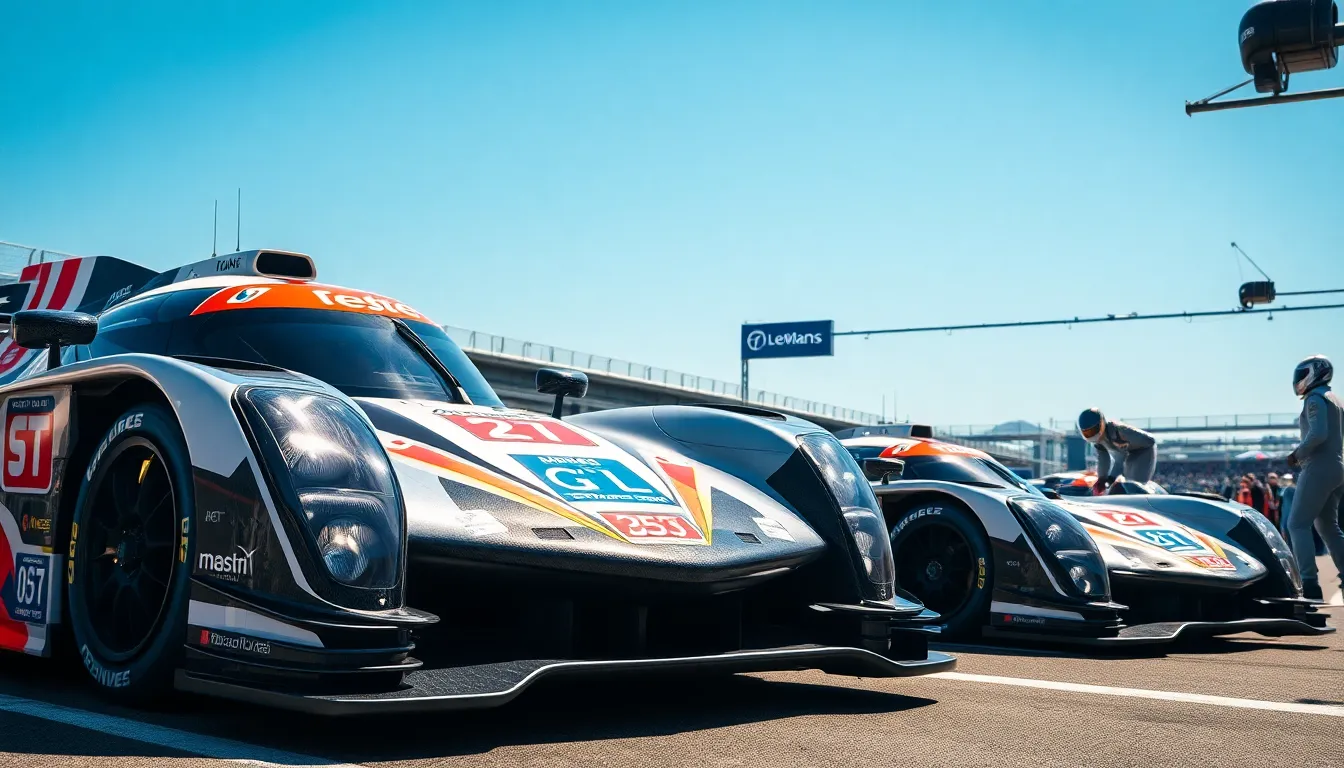
Today’s Le Mans features three distinct prototype and production car categories that showcase different approaches to endurance racing excellence. Each class serves exact purposes within the motorsport network while maintaining the event’s legendary competitive spirit.
LMP1 Hybrid Prototypes Leading Innovation
LMP1 hybrid prototypes represent the pinnacle of Le Mans technology integration. These cutting-edge machines combine traditional internal combustion engines with sophisticated hybrid systems that recover energy from braking and exhaust heat. Toyota’s TS050 Hybrid dominated this category with its 1000-horsepower powertrain that seamlessly blends a twin-turbo V6 engine with dual electric motor generators.
Aerodynamic efficiency defines LMP1 design philosophy through advanced computational fluid dynamics. Engineers create complex bodywork featuring active aerodynamic elements like adjustable rear wings and front splitters that optimize downforce based on track conditions. Manufacturers invest millions developing these prototypes as testbeds for future road car technologies including lightweight materials and energy management systems.
Regulatory restrictions challenge teams to maximize performance within strict technical parameters. FIA regulations limit fuel flow rates to 32.4 MJ per lap while requiring exact hybrid energy deployment strategies. Weight minimums of 878 kilograms force engineers to balance structural integrity with mass reduction using carbon fiber monocoques and titanium components.
LMP2 Customer Racing Answers
LMP2 cars provide accessible pathways for privateer teams entering professional endurance racing. These spec chassis prototypes use identical Oreca 07, Ligier JS P217, Dallara P217, or Riley Mk30 designs powered by standardized 4.2-liter Gibson V8 engines producing approximately 600 horsepower. Cost controls through common components make LMP2 participation financially viable for smaller racing operations.
Driver development opportunities flourish within LMP2’s structured competitive environment. Teams typically feature mixed lineups combining professional racers with gentleman drivers and rising stars seeking experience in prototype machinery. Bronze-rated amateur drivers must participate in each crew while silver and gold-rated professionals provide mentorship and speed.
Performance balance ensures close competition through technical regulations and success ballast systems. Organizers adjust weight penalties and fuel allocations based on previous race results to maintain competitive parity. Lap times consistently fall within narrow windows creating exciting multi-class racing scenarios throughout 24-hour duration events.
GTE Pro and Am Classes for Production-Based Vehicles
GTE Pro showcases manufacturer competition using heavily modified road car derivatives. Ferrari 488 GTE, Porsche 911 RSR, Ford GT, BMW M8, Aston Martin Vantage, and Chevrolet Corvette C8.R represent their respective brands through professional factory-supported efforts. These machines feature dramatic aerodynamic modifications including massive rear wings and aggressive front splitters while maintaining recognizable silhouettes from showroom models.
Technical regulations balance performance between different manufacturer platforms through equivalence formulas. Organizers adjust power output, weight distribution, fuel capacity, and aerodynamic configurations to ensure competitive equality regardless of engine displacement or configuration differences. Restrictor plates limit horsepower to approximately 500-550 depending on exact vehicle homologation requirements.
GTE Am provides opportunities for amateur drivers competing in older-specification machinery. Teams use previous-generation GTE cars that are at least one year old with mandatory amateur driver participation requirements. Bronze and silver-rated drivers must contribute important driving time while professional coaching helps develop their racecraft skills during extended stint durations.
Revolutionary Technologies First Seen in Le Mans Cars
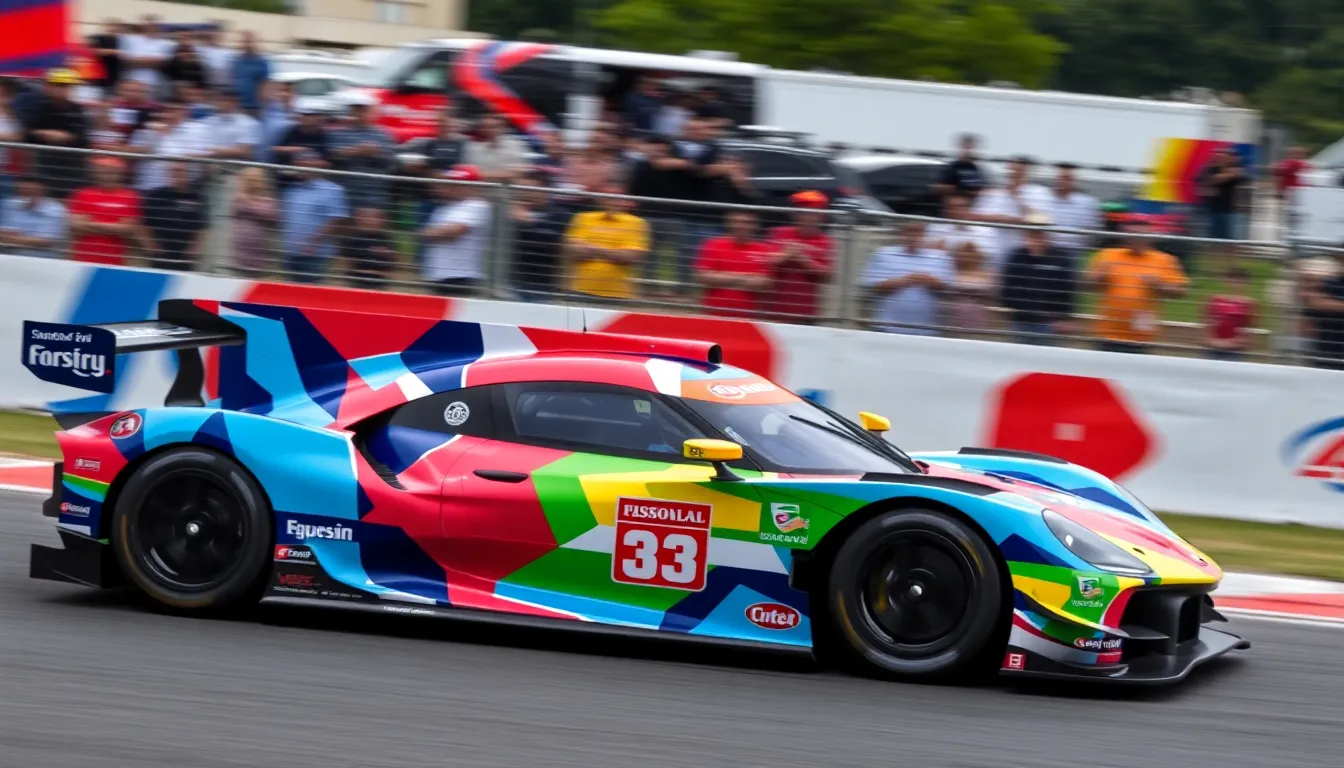
We see Le Mans as motorsport’s ultimate testing laboratory where cutting edge innovations prove their worth before reaching everyday vehicles. Technologies that emerge from the grueling 24-hour endurance test often reshape the entire automotive industry within a decade.
Hybrid Power Systems and Energy Recovery
Hybrid powertrains made their competitive debut at Le Mans in 2012 with Toyota’s TS030 prototype. Audi’s R18 e-tron quattro became the first hybrid vehicle to win overall in 2012, combining a diesel V6 with electric motors powered by flywheel energy storage. We witnessed history when this groundbreaking system captured kinetic energy during braking and released it for additional power during acceleration.
Toyota revolutionized energy recovery further with their TS040 and TS050 models, implementing supercapacitor technology that stored electrical energy more efficiently than traditional batteries. Modern LMP1 hybrids can recover up to 8 megajoules of energy per lap, equivalent to approximately 2.2 kilowatt-hours of stored power. Porsche’s 919 Hybrid demonstrated the effectiveness of these systems by winning three consecutive championships from 2015 to 2017, proving that hybrid technology could dominate endurance racing’s most demanding competition.
Advanced Aerodynamics and Downforce Management
Aerodynamic innovations at Le Mans have consistently pushed the boundaries of what’s possible in automotive design. Ground effect aerodynamics first appeared in prototype racing during the late 1970s, with Porsche’s 956 and 962 models generating massive downforce through carefully sculpted underbody channels. We’ve observed how these venturi tunnels create low-pressure zones beneath the car, effectively sucking it to the track surface at high speeds.
Active aerodynamics emerged as a game changer with systems that automatically adjust wing angles based on speed and cornering forces. Modern LMP1 cars feature drag reduction systems that flatten rear wings on long straights, increasing top speeds by up to 15 mph while maintaining optimal downforce through corners. Computational fluid dynamics and wind tunnel testing at Le Mans have evolved to include real-time telemetry data, allowing teams to fine-tune aerodynamic packages during practice sessions.
Lightweight Materials and Carbon Fiber Construction
Carbon fiber construction made its Le Mans debut in the early 1980s with McLaren’s prototype chassis development. We trace the evolution from simple carbon fiber body panels to complete monocoque chassis that weigh less than 200 pounds while providing exceptional crash protection. Modern LMP1 cars use carbon fiber honeycomb structures that are five times stronger than steel while weighing 75% less than equivalent aluminum components.
Advanced composite materials now extend beyond structural elements to include carbon fiber brake discs, suspension components, and even wheel assemblies. Toyota’s TS050 features a carbon fiber tub that weighs just 85 kilograms, demonstrating how material science advances at Le Mans directly influence road car development. Manufacturers like BMW and Lamborghini have successfully transferred these lightweight construction techniques to their high-performance street vehicles, reducing overall vehicle weight by up to 100 pounds compared to traditional materials.
Most Successful Le Mans Cars by Manufacturer
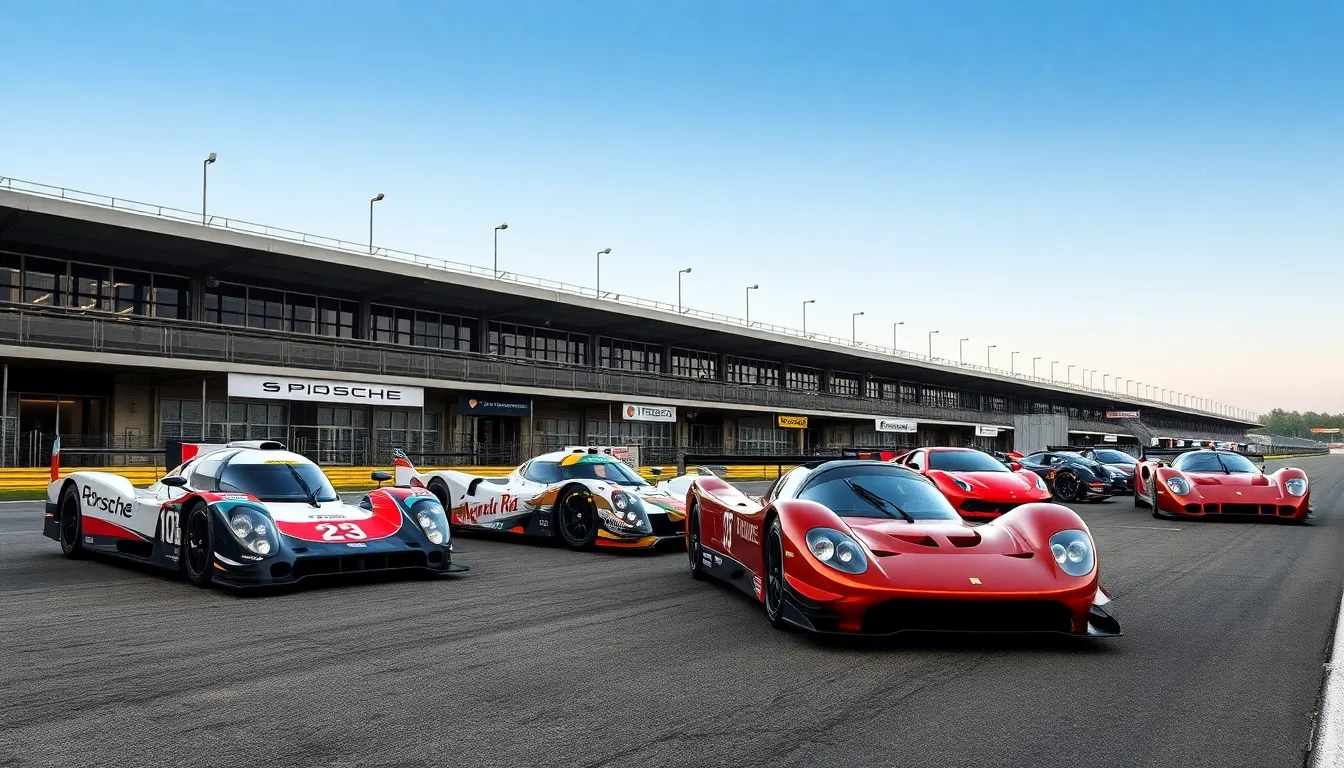
We’ve witnessed several manufacturers establish legendary legacies at Le Mans throughout the decades. Each brand’s approach to endurance racing has shaped the sport’s evolution and automotive history.
Porsche’s Record-Breaking Championship Legacy
Porsche stands as Le Mans’ most successful manufacturer with 19 overall victories spanning from 1970 to 2017. The German brand’s dominance began with the revolutionary 917 models that claimed consecutive wins in 1970 and 1971, setting speed records that stood for years.
Throughout the 1980s, Porsche’s 956 and 962 prototypes dominated the competition with advanced ground effect aerodynamics and turbocharged engines. We saw these machines claim seven consecutive victories from 1982 to 1987, establishing Porsche as the benchmark for endurance racing excellence.
Modern success continued with the 919 Hybrid program from 2014 to 2017, where Porsche secured three consecutive wins using cutting edge hybrid technology. The 919’s energy recovery systems and lightweight construction demonstrated how traditional racing expertise could adapt to contemporary environmental demands.
| Porsche Le Mans Statistics | Count |
|---|---|
| Overall Victories | 19 |
| Consecutive Wins (1982-1987) | 6 |
| 919 Hybrid Victories | 3 |
| First Victory | 1970 |
Audi’s Dominance in the Modern Era
Audi transformed Le Mans competition during their remarkable 18 year campaign from 1999 to 2016. The German manufacturer claimed 13 overall victories, introducing diesel technology to prototype racing with their groundbreaking R10 TDI in 2006.
Revolutionary diesel engines provided superior fuel efficiency and torque characteristics that perfectly suited endurance racing demands. We witnessed Audi’s R10, R15, and R18 models demonstrate how alternative powertrains could achieve both performance and sustainability goals simultaneously.
Hybrid technology integration marked Audi’s final competitive phase, with the R18 e-tron quattro becoming the first hybrid vehicle to win Le Mans overall in 2012. Their sophisticated energy recovery systems and quattro all wheel drive technology set new standards for prototype development.
Ferrari’s Passionate Racing Heritage
Ferrari’s Le Mans legacy spans seven decades, with nine overall victories showcasing Italian engineering excellence and racing passion. The Maranello manufacturer’s golden era occurred during the 1960s, claiming six consecutive wins from 1960 to 1965 with their legendary 250 series vehicles.
Classic Ferrari models like the 250 TR, 250 LM, and 330 P series combined beautiful aesthetics with competitive performance through naturally aspirated V12 engines. We’ve seen how Ferrari’s approach emphasized driver skill and mechanical reliability over pure technological complexity.
Modern Ferrari participation focuses on the GTE Pro class, where 488 and 296 models continue the brand’s competitive spirit. Their commitment to naturally aspirated engines and traditional racing values maintains Ferrari’s distinctive identity within contemporary motorsport competition.
Current Le Mans Cars Dominating the Track
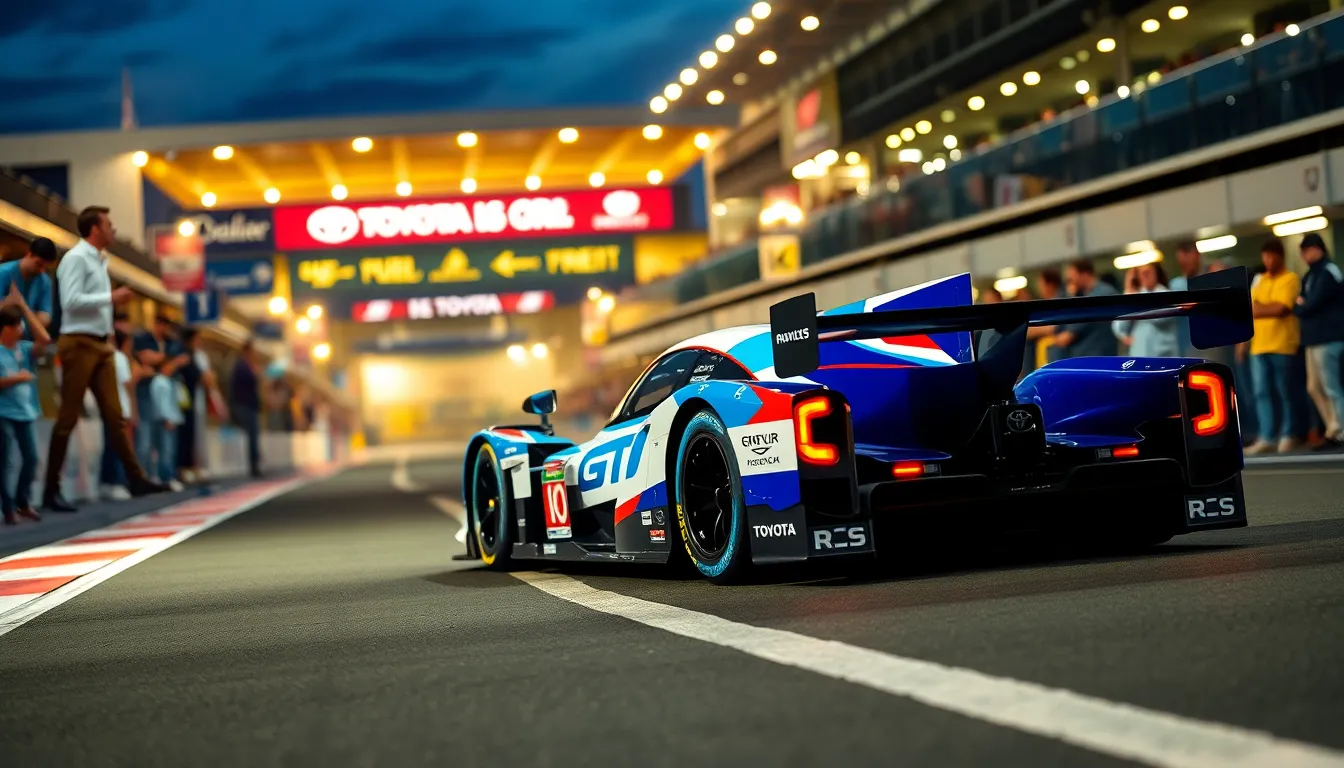
Today’s Le Mans grid features a thrilling battle between hybrid prototypes that represent the pinnacle of endurance racing technology. We’re witnessing an incredible era where manufacturers push the boundaries of efficiency and speed through revolutionary powertrains.
Toyota GR010 Hybrid’s Championship Success
Toyota’s GR010 Hybrid stands as the current benchmark in LMP1 competition, combining a twin-turbo V6 engine with advanced hybrid systems. The Japanese manufacturer secured back-to-back victories in 2021 and 2022, demonstrating the maturity of their hybrid technology that delivers over 680 horsepower while maintaining exceptional fuel efficiency.
Performance specifications showcase Toyota’s engineering prowess:
| Specification | Toyota GR010 Hybrid |
|---|---|
| Engine | 3.5L Twin-Turbo V6 |
| Hybrid Power | 272 HP |
| Total Power | 680+ HP |
| Weight | 1,030 kg |
| Top Speed | 330+ km/h |
Aerodynamic refinements distinguish the GR010 from its predecessors, featuring optimized bodywork that reduces drag while maintaining crucial downforce levels. Toyota’s reliability has proven decisive in recent campaigns, with their cars consistently finishing races while competitors face technical difficulties.
Driver lineups reflect Toyota’s commitment to excellence, featuring industry-class talents like Sébastien Buemi and Brendon Hartley who’ve mastered the car’s complex energy management systems. The team’s strategic approach to tire management and fuel consumption has become a template for success in modern endurance racing.
Ferrari 499P’s Return to Glory
Ferrari’s 499P marks the Italian manufacturer’s triumphant return to the top step of the Le Mans podium after a 50-year absence. This LMH prototype secured victory in 2023, ending decades of heartbreak and establishing Ferrari as a serious contender in the hypercar era.
Revolutionary design philosophy drives the 499P’s success, combining Ferrari’s racing DNA with cutting-edge hybrid technology that produces over 670 horsepower. The car’s distinctive styling pays homage to Ferrari’s sports car heritage while incorporating modern aerodynamic principles that maximize performance on the Sarthe circuit.
Hybrid integration represents Ferrari’s leap into sustainable racing technology, featuring a sophisticated energy recovery system that captures kinetic energy during braking phases. Development drew heavily from Ferrari’s Formula 1 expertise, particularly in areas of energy management and thermal efficiency that prove crucial during the 24-hour marathon.
Manufacturing precision ensures every component meets Ferrari’s exacting standards, from the carbon fiber monocoque to the advanced suspension systems that provide optimal handling characteristics. The 499P’s success has reinvigorated Ferrari’s Le Mans program and attracted top-tier drivers eager to compete for the prestigious overall victory.
Porsche 963’s Latest Engineering Marvel
Porsche’s 963 represents the German manufacturer’s newest assault on Le Mans victory, combining decades of endurance racing experience with modern LMDh regulations. This prototype debuted in 2023 with immediate competitiveness, showcasing Porsche’s ability to adapt their engineering expertise to new technical frameworks.
Advanced powertrain technology powers the 963 through a twin-turbo V8 engine paired with a standardized hybrid system that delivers consistent performance throughout extended racing sessions. Porsche’s engineers optimized the car’s aerodynamic package specifically for Le Mans, creating exceptional stability at high speeds while maintaining agility through the circuit’s technical sections.
Key technical features highlight Porsche’s innovation:
| Component | Specification |
|---|---|
| Engine | 4.6L Twin-Turbo V8 |
| Hybrid Output | 268 HP |
| Transmission | 7-Speed Sequential |
| Downforce | Variable Active |
| Brake System | Carbon Ceramic |
Driver feedback has praised the 963’s predictable handling characteristics and strong braking performance, essential qualities for handling traffic during night sessions. Porsche’s methodical development approach focuses on reliability and consistency, drawing from their extensive database of Le Mans victories spanning multiple decades.
Testing programs have validated the 963’s competitiveness across various racing conditions, from wet weather performance to tire degradation management. The car’s modular design allows for rapid setup changes between practice sessions, giving Porsche teams tactical advantages during race weekends.
How Le Mans Cars Influence Road Car Development
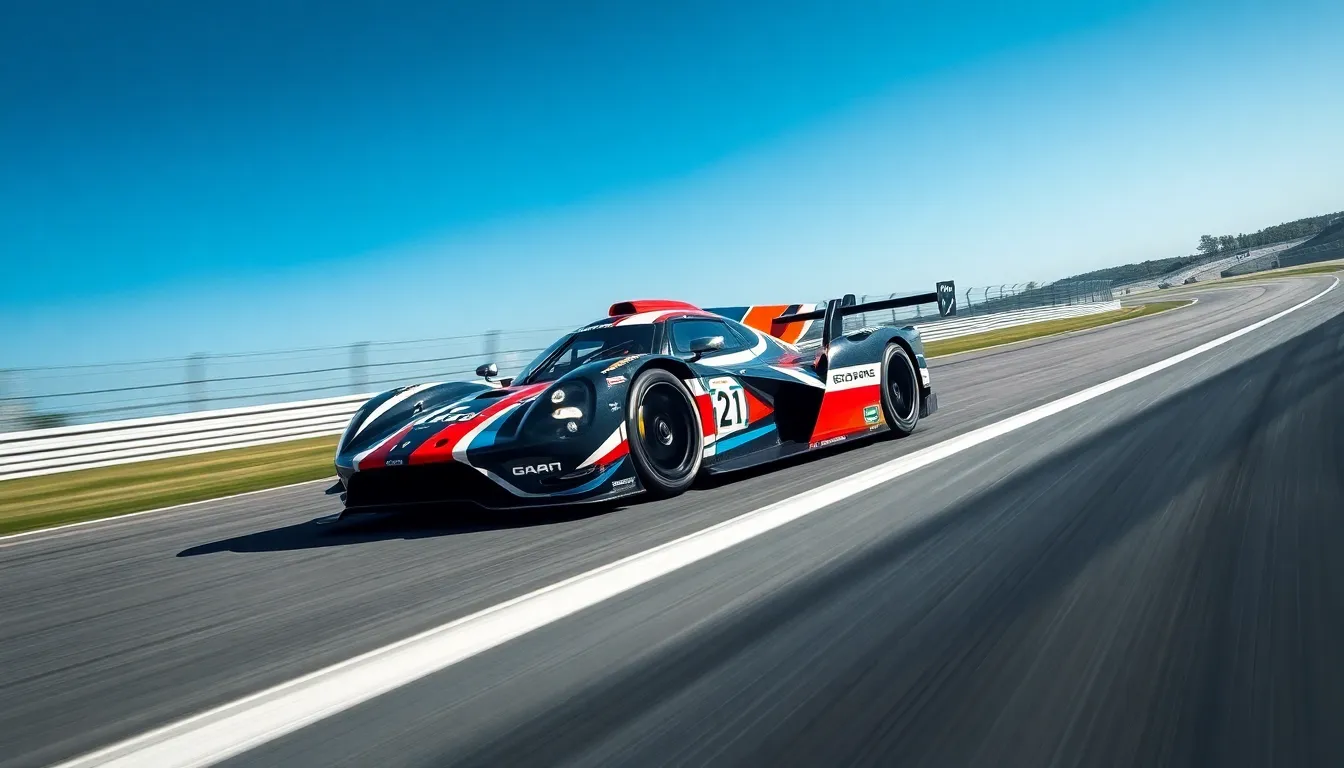
Le Mans serves as the ultimate proving ground for automotive technologies that eventually find their way into our daily drivers. Racing’s relentless pursuit of performance and reliability creates innovations that benefit every car owner worldwide.
Technology Transfer from Track to Street
Hybrid powertrains represent the most important technology transfer from modern Le Mans racing to consumer vehicles. Toyota’s experience with the TS040 and TS050 hybrid prototypes directly influenced the development of their Prius and Camry hybrid systems. Porsche’s 919 Hybrid program provided crucial data for their Cayenne and Panamera E-Hybrid models, proving that racing hybridization translates effectively to road cars.
Energy recovery systems developed for LMP1 cars now appear in mainstream vehicles through regenerative braking technology. Ferrari’s 499P uses kinetic energy recovery that mirrors the systems found in their LaFerrari and SF90 Stradale supercars. BMW’s i8 incorporated energy storage answers first tested in their failed LMP1 program from the early 2010s.
Advanced materials engineering flows directly from Le Mans prototypes to production vehicles. Carbon fiber construction techniques pioneered in racing now reduce weight in everything from BMW’s i-series to McLaren’s road cars. Audi’s carbon fiber expertise from their R18 program directly benefited their R8 and A8 models, making them lighter and more efficient.
Aerodynamic innovations tested at Circuit de la Sarthe improve fuel efficiency and handling in road cars. Active aerodynamics from racing prototypes now appear in vehicles like the Mercedes-AMG GT and Porsche 911 Turbo S. Ground effect principles developed for LMP cars influence underbody design in modern sports cars and luxury sedans.
Safety Innovations Born from Racing
Crash structure design developed through Le Mans racing saves lives in everyday vehicles. Carbon fiber safety cells pioneered in LMP1 prototypes influence the passenger compartments of modern supercars and luxury vehicles. Toyota’s experience with impact-absorbing structures in their racing program directly improved the safety of their road car lineup.
Fire suppression systems refined through endurance racing now protect drivers in high-performance road cars. Porsche’s automatic fire extinguishing technology from their 919 Hybrid appears in modified forms in their GT models. Ferrari incorporates racing-derived fire safety measures in their road-going supercars.
Advanced seatbelt and harness systems tested in Le Mans cars improve restraint effectiveness in production vehicles. Racing seat designs influence ergonomics and safety in performance-oriented road cars. Mercedes-AMG incorporates racing-inspired safety cell construction in their high-performance models.
Roll cage principles from prototype racing strengthen the A-pillars and roof structures of modern cars. Lightweight yet strong safety cage designs improve crashworthiness without adding excessive weight. Audi’s experience with safety structures in their R-series prototypes enhanced the safety of their entire road car range.
Performance Enhancements for Consumer Vehicles
Turbocharging technology refined through Le Mans competition now powers millions of road cars worldwide. Ford’s EcoBoost engines benefit from lessons learned during their GT program development. Porsche’s turbocharged flat-six engines in the 911 lineup incorporate technology first tested in their racing prototypes.
Transmission systems developed for endurance racing improve reliability and efficiency in road cars. Dual-clutch technology pioneered in racing now appears in everything from Volkswagen Golf GTI to Ferrari’s entire lineup. Sequential gearbox principles influence the design of modern automatic transmissions.
Suspension technology tested over 24-hour races provides superior handling and comfort in production vehicles. Adaptive dampers developed for racing prototypes now appear in luxury sedans and sports cars. Porsche’s PASM system incorporates lessons learned from their extensive Le Mans experience.
Brake system innovations from endurance racing prevent fade and improve stopping power in road cars. Carbon-ceramic brakes developed for racing now equip high-performance production vehicles. Heat management techniques from Le Mans cars improve brake longevity in everyday driving conditions.
Engine management systems refined through racing optimize fuel efficiency and performance in consumer vehicles. Electronic control units developed for racing provide precise engine control in modern road cars. Variable valve timing systems benefit from racing development programs across multiple manufacturers.
Conclusion
Le Mans cars represent the pinnacle of automotive achievement where cutting-edge technology meets unrelenting human determination. We’ve witnessed how these extraordinary machines have evolved from simple endurance racers to sophisticated hybrid prototypes that push the boundaries of what’s possible in motorsport.
The legacy of Le Mans extends far beyond the race track influencing every vehicle we drive today. The innovations pioneered at Circuit de la Sarthe continue to shape our automotive future proving that the pursuit of racing excellence directly benefits drivers worldwide.
Whether it’s Porsche’s engineering mastery Toyota’s hybrid dominance or Ferrari’s triumphant return these remarkable machines embody the spirit of innovation that makes Le Mans the industry’s greatest endurance race. They remind us that true automotive greatness isn’t just measured in speed but in the relentless pursuit of perfection.
Frequently Asked Questions
What makes Le Mans cars special compared to other racing vehicles?
Le Mans cars are designed for endurance racing, specifically the grueling 24-hour race at Circuit de la Sarthe. Unlike other racing cars built for speed alone, these machines must balance performance with reliability, efficiency, and durability. They serve as testing grounds for cutting-edge automotive technologies that eventually benefit everyday cars, making them unique laboratories for innovation.
How have Le Mans cars evolved over the decades?
Le Mans cars have undergone revolutionary changes from the 1920s to today. Early Bentley Speed models established endurance racing, while the 1950s-60s brought Ferrari’s dominance and advanced technologies like disc brakes. The modern era introduced hybrid powertrains, carbon fiber construction, and advanced electronics, making contemporary cars lighter, safer, and more efficient than their predecessors.
Which are the most iconic Le Mans cars in racing history?
The Ford GT40 dominated the 1960s with consecutive victories from 1966-1969, marking American success in European racing. The Porsche 917 redefined speed and aerodynamics in the early 1970s. Audi’s R8 and R10 programs revolutionized endurance racing by proving diesel technology’s effectiveness, fundamentally changing perceptions of diesel power in high-performance motorsport.
What are the different categories of Le Mans cars competing today?
Current Le Mans features several categories: LMP1 hybrid prototypes representing the pinnacle of technology, LMP2 customer racing with standardized designs for privateer teams, and GTE Pro and Am classes for production-based vehicles. Each category maintains competitive balance through technical regulations while fostering innovation and driver development in endurance racing.
What revolutionary technologies were first developed in Le Mans cars?
Le Mans pioneered hybrid power systems, starting with Toyota’s TS030 in 2012 and Audi’s R18 e-tron quattro. Advanced aerodynamics including ground effect designs, energy recovery systems like supercapacitors, and lightweight carbon fiber construction all debuted here. These innovations enhanced racing performance while influencing everyday vehicle design and manufacturing.
Which manufacturers have been most successful at Le Mans?
Porsche leads with 19 overall victories from 1970-2017, dominating with models like the 917, 956, and 919 Hybrid. Audi achieved 13 victories, revolutionizing racing with diesel technology and hybrid systems. Ferrari holds nine overall victories and maintains a rich heritage, particularly excelling in the GTE Pro class with their 488 and 296 models.
What are the current dominant Le Mans cars?
Toyota’s GR010 Hybrid sets the LMP1 benchmark with back-to-back victories in 2021-2022, featuring a powerful twin-turbo V6 and advanced hybrid systems. Ferrari’s 499P marked their return to victory after 50 years, while Porsche’s 963 combines extensive racing experience with modern LMDh regulations, all exemplifying cutting-edge technology and engineering excellence.
How do Le Mans technologies benefit everyday cars?
Le Mans serves as the ultimate proving ground for automotive innovations that transfer to consumer vehicles. Technologies like hybrid powertrains, energy recovery systems, turbocharging, advanced transmission systems, and suspension technology are refined through racing competition. These developments enhance performance, safety, and efficiency in everyday cars, improving the driving experience for consumers worldwide.

